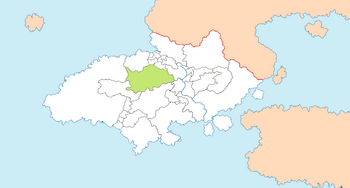Archduchy of Greater Vethringen: Difference between revisions
No edit summary |
No edit summary |
||
| Line 1: | Line 1: | ||
{{wip}} | |||
{{Infobox country | {{Infobox country | ||
|native_name = ''Erzherzogtum Groß Vethringen'' (Alemannisch) | |native_name = ''Erzherzogtum Groß Vethringen'' (Alemannisch) | ||
Revision as of 02:04, 11 November 2021
This article is incomplete because it is pending further input from participants, or it is a work-in-progress by one author. Please comment on this article's talk page to share your input, comments and questions. Note: To contribute to this article, you may need to seek help from the author(s) of this page. |
Archduchy of Greater Vethringen Erzherzogtum Groß Vethringen (Alemannisch) | |
|---|---|
| 1623 | |
 Location of the Archduchy of Greater Vethringen | |
| Status | State |
| Capital | Greifsdorf |
| Common languages | Alemannisch |
| Demonym(s) | Vethringenian |
| Government | Hereditary Archduchy |
• Archduke | Johann III |
| History | |
• Established | 20 August 1623 |
• Kingdom of Vethringen founded | 495 |
• Vassal State to the Empire | 730 |
• Archduchy of Greater Vethringen founded | 1623 |
| Currency | Thaler |
The Archduchy of Greater Vethringen is a constituent state of the Empire of Dolchland that is a semi-independent constituent state of the Empire. Located in the Vethringen region, it shares a border with the Duchy of Lower Vethringen to the north, as well as Habstria to the west, as well as Tale-Beiberg and Westervark to the east.
In the arrival of Dolchic settlers to modern-day Dolchland, the region which would become Vethringen was universally colonised by the Vetter tribe or tribal confederation. They consolidated relatively quickly, establishing an ancient kingdom in 495. The Kingdom would come to be bordered by the ($EMPIRE) rising in the west, and seeing potential in joining with this new power, renounced their Kingly title to join as vassals to the Empire, and became the early Archduchy of Vethringen. This state continued until 1617, when the Vethringen Succession War broke out, with two rival factions, the Legitimists ruling from Greifsdorf, who had selected a cousin of the outgoing Archduke who was of the house Ausburg-Vethringen to rule, and the Nachfolgists, ruling from Ritterburg, who had selected the legitimised bastard son of the outgoing Archduke to rule. The war resulted in somewhat of a stalemate, though the Legitimist cause was supported by the Ausburg Emperor, and so the title of Archduke remained with the Legitimist ruler, who formed the Archduchy of Greater Vethringen, while the Nachfolgists formed the Duchy of Lesser Vethringen.

